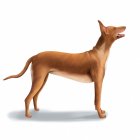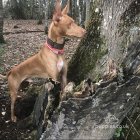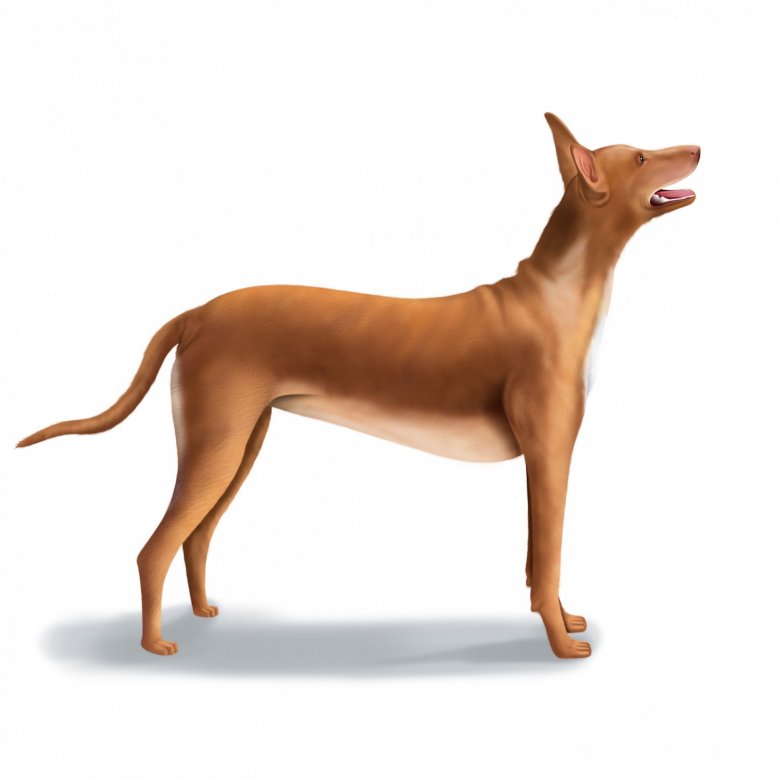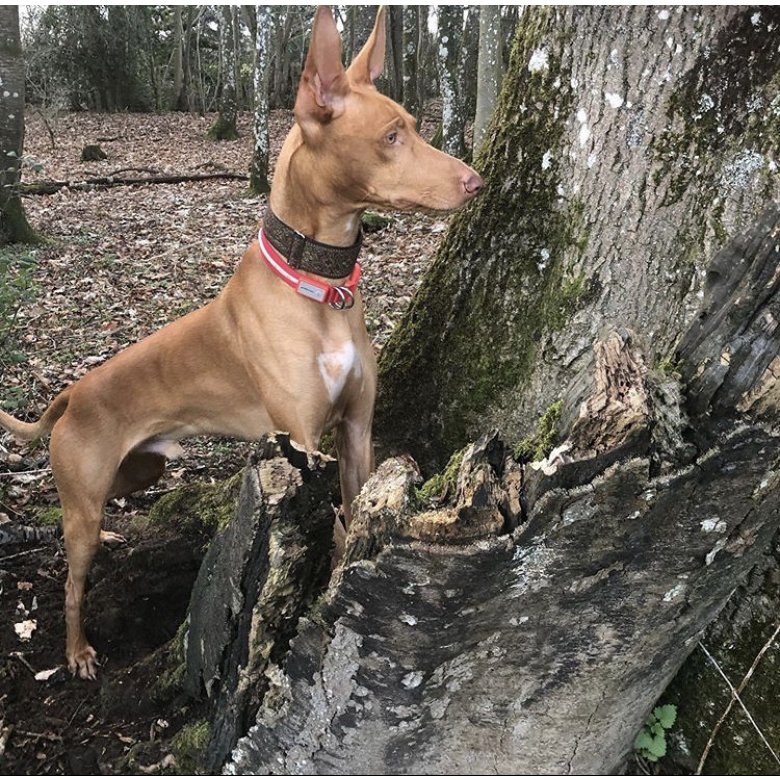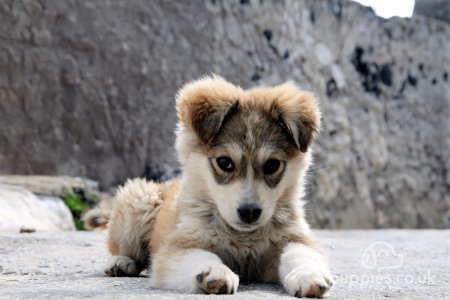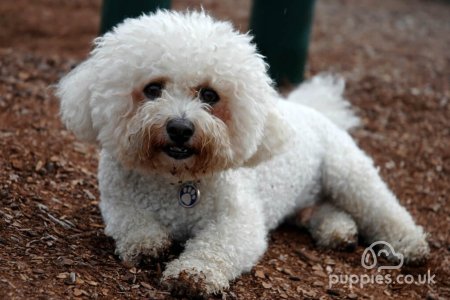Pharaoh Hound (Kelb Tal-Fenek, Rabbit Dog)
Overview
The national dog of Malta is not the Maltese, as one may assume, but it is in fact the affectionate and loyal Pharaoh Hound. With ancient roots, this rabbit hunting dog is called Kelb Tal-Fenek in Maltese and was prized for centuries and possibly much further back in history for hunting rabbits.
Today, the slender yet unique appearance and wonderful temperament of the Pharaoh Hound has made this breed a welcome addition to loving homes worldwide, including here in Britain.
Physical Appearance
Medium to large-sized in stature, the spitz-type Pharaoh Hound is noble and clean-cut in his appearance. Simultaneously exuding grace and power, the lean musculature of a Pharaoh Hound is remarkable, as is their fast, free, and graceful gait.
Their amber-coloured eyes blend in with their coat, whilst their medium-high set, erect ears show alertness. Their medium-set tails are carried erect and high when at a gait.
Pharaoh Hounds have a short, glossy coat of fur that can vary from soft to harsh. Acceptable coat colours include tan with white markings, found on the tip of the tail, chest, and toes. Flecking is undesirable.
The Pharaoh Hound is somewhat comparable to other spitz breeds and most closely resembles the Cirneco dell’Etna and to a lesser extent the Ibizan Hound, Azawakh, and Basenji.
How big do Pharaoh Hound dogs get?
Character Traits
The temperament of the Pharaoh Hound can be described as active, intelligent, and sociable. An ancient purebred, the Pharaoh Hound retains a streak of independence and a superb prey drive which can lead to chasing, as they were originally bred to chase rabbits.
It is a fair challenge to describe the temperament of a Pharaoh Hound in simple terms, due to their long and perhaps ancient history as a breed. What is clear, however, is that they are quite unique amongst breeds and as such require experience for training and socialisation, thus making them a poor choice for first-time dog owners.
As puppies, they tend to be playful well into adulthood and rarely if ever show any signs of aggression.
Are Pharaoh Hound dogs intelligent? Somewhat.
Are Pharaoh Hound dogs affectionate? Yes, somewhat.
Do Pharaoh Hound dogs have high or low energy levels? Low energy.
Are Pharaoh Hound dogs loyal? Yes.
Are Pharaoh Hound dogs playful? Yes, very.
Are Pharaoh Hound dogs aggressive? Not at all.
Are Pharaoh Hound dogs easy to train? Yes.
Are Pharaoh Hound dogs good guard dogs? No.
Ability to Socialise
Around owners and their families, Pharaoh Hounds develop a loving, affectionate bond of loyalty. Normally, there shouldn’t ever be any problems with aggression, but keep an eye out if you have toddlers at home as they can become fairly boisterous during playtime.
For owners with other dogs around the home, Pharaoh Hounds tend to get along well provided they’ve been well socialised. Smaller pets, however, will likely trigger their innate prey drive and lead to chasing or perhaps exerting dominance.
Although they appear to be watchful and perhaps even cautious, Pharaoh Hounds tend to get along well with strangers.
Do Pharaoh Hound dogs get along with other pets? No.
Do Pharaoh Hound dogs get along with other dogs? Yes.
Are Pharaoh Hound dogs good with kids? Yes.
Are Pharaoh Hound dogs good with strangers? Yes.
Lifestyle Suitability
Pharaoh Hounds are best suited for owners living in rural environments, preferably with large gardens that are ideally fenced off. They are, however, fairly adaptable and could potentially live in smaller homes, although this is not ideal as they naturally prefer large, open spaces.
Owners will also be pleased to know that Pharaoh Hounds don’t drool or shed very much at all, and can be left alone at home for moderate periods of time provided that they aren’t overly neglected. Moreover, they do better in warm weather than in the cold, so here in Britain they’ll do all right in the summer but will yearn for someplace warm come winter.
On account of their challenging temperament that is quite unique amongst breeds, Pharaoh Hounds are not the best choice for first-time owners. Experienced dog owners, however, will surely enjoy the rewarding experience of raising such a loving companion.
Are Pharaoh Hound dogs good for first-time owners? No.
Are Pharaoh Hound dogs hypoallergenic? No.
Are Pharaoh Hound dogs prone to drooling? No.
Are Pharaoh Hound dogs a good breed for apartment living? Yes, but they do better in larger homes with gardens.
Do Pharaoh Hound dogs shed a lot? Hardly any shedding at all.
Do Pharaoh Hound dogs bark a lot? No, hardly at all.
Can Pharaoh Hound dogs be left alone at home? Yes, for moderate lengths of time.
Can Pharaoh Hound dogs handle the heat? Yes, they prefer warm weather.
Can Pharaoh Hound dogs handle cold temperatures? Yes, but not too cold.
Are Pharaoh Hound dogs sensitive to loud noises? Yes.
General Health & Health Issues
Although an old breed dating back centuries (or possibly millennia), Pharaoh Hounds are prone to several hereditary health problems and therefore rank slightly lower than average in terms of overall health.
Many of the health problems they may develop as they age can be tested and diagnosed by your veterinarian, and it’s always better to have them inspected sooner rather than later.
Some common problems include:
Eye infections: always endeavour to have your Pharaoh Hound inspected in the eyes (and ears, too) for signs of possible infection;
Hip dysplasia: the lean musculature and skeletal structure of the Pharaoh Hound means they are prone to hip dysplasia, which can manifest as a limp gait or lameness in the leg(s);
Skin allergies: due to their close, short coats of fur, Pharaoh Hounds may be prone to developing skin irritations or allergies. This could also stem from a poor diet;
Bloat: as with many breeds, Pharaoh Hounds are prone to bloat and perhaps gastric torsion from a poor diet or from an irregular feeding regimen.
How long do Pharaoh Hound dogs live? - 12-14 years
Exercise & Play Time
Bred to hunt rabbits in his native Malta, the Pharaoh Hound has very demanding exercise needs that must be considered before purchase or adoption. No less than two hours should be devoted to exercise and playtime every day, which should always include a brisk morning walk or jog followed by at least an hour’s worth of vigorous exercise in the afternoon or evening.
Allow them to run off-lead if safe to do so, preferably on your own property in a field or fenced off area such as a rear garden. They love to chase and will most certainly want to play catch with you until your arms tire out, but that’s a good thing since a tired dog is a happy dog.
How much exercise does a Pharaoh Hound dog need? - At least 2 hours per day
Do Pharaoh Hound dogs like water play? Yes, but always maintain supervision.
Nutrition & Feeding
It is important that your Pharaoh Hound consume the right quantity and the right quality of food delivered in 2-3 feeding sessions per day. As a breed known to develop bloat as he ages, you’ll need to maintain a fairly strict feeding regimen and ensure that your Pharaoh Hound is not overeating.
Owners may wish to choose an alternative to extruded dog food (i.e. kibble) and instead feed them a rich diet in vitamins, minerals, and nutrients such as raw food or a cold-pressed diet instead. This may alleviate many potential health problems such as bloat or skin allergies, but you should always consult your veterinarian to ensure that this diet is adequate for your Pharaoh Hound’s health and development.
Are Pharaoh Hound dogs prone to weight gain? Yes, especially as they age.
How much should I feed a Pharaoh Hound puppy? About 180-360g per day, in 2-3 sessions.
How much should I feed an adult Pharaoh Hound dog? About 215-340g per day, in total.
Care & Maintenance
Pharaoh Hounds are very easy to care for and to maintain the lustre of their short coats. This is one of their major advantages, but owners should also take care because such short coats also expose their skin which is prone to allergic reactions.
For emotional care, Pharaoh Hounds are similarly fairly low-stress and hassle-free. They do fairly well on their own and can behave independently at times, but as with almost all breeds, they should never be neglected or left feeling lonely out of habit.
- Grooming: once a week, brush your Pharaoh Hound’s coat with chamois leather to keep it shiny and clean. Inspect the ears and eyes for signs of infection.
- Emotional care: try to ensure that someone is always home to accompany your Pharaoh Hound. They can remain alone for a few hours throughout the day, however.
History of the Pharaoh Hound
One might assume that given his name, the Pharaoh Hound dates back to ancient Egypt. This was a long-held belief, backed up by similar types of breeds depicted on hieroglyphs and tomb paintings found in Egypt. While it is true that in the middle of the 20th century, skeletal remains of hunting dogs were found in tombs in ancient Egypt, modern evidence suggests that the Pharaoh Hound is, in fact, native to Malta and only traces his history back a few centuries (as opposed to a few millennia).
With his closest relative being the Cirneco dell'Etna from nearby Italy, the split between the two breeds can perhaps be dated to only a couple of centuries ago. Pharaoh Hounds (or at least their predecessor breeds) were in demand outside of Malta, such as in France, by rabbit hunters since at least the late Renaissance period.
The Pharaoh Hound was formally recognised by the Kennel Club in 1974 and is recognised by the Federation Cynologique Internationale and the American Kennel Club as well.
Interesting Facts About Pharaoh Hound Dogs
The first litter of Pharaoh Hounds outside of his native Malta was here in the UK in 1963;
The first Pharaoh Hound to be introduced to the UK in 1963 for the purposes of breeding was named Bahri;
The Pharaoh Hound is recognised as Malta’s national dog breed.
Getting a Pharaoh Hound Puppy
Before purchasing or adopting any puppy, including a Pharaoh Hound puppy, we encourage you to read our buying guide first. The unique needs of this breed require plenty of planning and preparation, but when you feel ready to purchase a Pharaoh Hound you can rest assured that we only work with reputable breeders in the UK.
How much does a Pharaoh Hound cost to buy? - Over £500.
How much does a Pharaoh Hound cost to feed? - An adult Pharaoh Hound costs about £1.30-£1.50 per day to feed.
How much does insurance for a Pharaoh Hound cost? - About £25-£45 per month.
Sensible alternatives to purchasing a new Pharaoh Hound puppy include rescue and adoption.
Additional resources can be found via Pharaoh Hound registries and associations such as:






